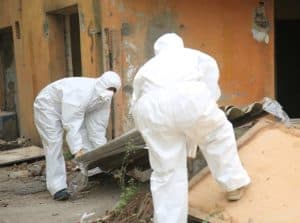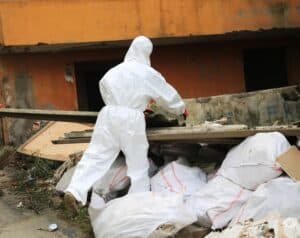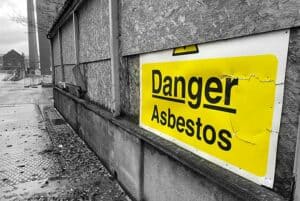How Do I Spot Asbestos In My Home? – A4 Asbestos Answers
Asbestos first became a popular building material in the1950’s, it has been used underneath kitchen sinks, behind tiles, in garage roof tiles, as a form of insulation surrounding pipes and boilers and can even be found in older paint. It has been used as fire protection on structural supports such as columns and beams. Asbestos thermal pipe lagging is a high hazard product. Other uses are;
- Textured decorative coatings
- Textured coatings, such as Artex, contain a small amount of asbestos.
- Pipe insulation
- Floor tiles
- Vinyl (PVC) or thermoplastic tiles contain asbestos.
- Asbestos cement roof sheeting
- It is often found on industrial building roofs and walls.
- Roof guttering and downpipes were often made of asbestos cement.
- Water tanks and toilet cisterns
- Loose asbestos has been used in ceiling and wall cavities
Asbestos can come in all shapes, colours and sizes and as indicated above has had many uses over the past years. The three types to look for are blue, brown and white, these are mainly found in many different building products. If it has been mixed with other materials it is harder to know if you have found it or not.
The government body, The Health and Safety Executive,have produced an image gallery that shows real photographs of asbestos containing materials that could still be found in buildings today. Knowing what you are looking for or what you may potentially come across could be a lifesaver.
How can I check for asbestos in my home?
You might think that checking for asbestos might put your mind at ease but it isn’t so easy finding out whether or not you have asbestos in your home. Having samples taken from your home is the safest & most dependable way of checking your home for asbestos.
Having a professional asbestos company test different areas of your home makes use of professional lab technology that determines not only the type of asbestos you have but the potential risks of the asbestos too.
There are ways you can collect samples yourself to be sent off to an independent testing laboratory, but we would always recommend acquiring the assistance of a professional asbestos company to take the samples. Hiring a professional minimises the amount of asbestos that you expose yourself and your family too.
What do I do if I find asbestos in my house?
Getting rid of asbestos is a certainty if the asbestos found in your home is damaged and poses a threat to you. How the asbestos is removed depends on where the asbestos on the property, the condition of the material containing the asbestos as well as if it’s friable or non-friable. Friable asbestos crumbles much more easily than other forms, which can cause harmful particles of asbestos to be released into the air. Non-friable asbestos is usually bonded with another material which makes it less of a risk. Non-friable asbestos is still a risk however if the material is damaged, as the loose debris from that can release fibres also.
If the material/source of the asbestos is in good shape, then the asbestos is much less of a risk since it’s only when the asbestos fibres are able to be released into the air which causes the problem. There are services that can repair any broken asbestos, sealing the harmful particles which could be a good option for those looking to retain the look of their home. However, know that all materials degrade over time and that any material that contains asbestos will eventually degrade to the point it can release the harmful asbestos fibres. If you’re going to maintain the sources of asbestos in your home rather than removing them, then you need to constantly monitor for signs of deterioration & damage.
Asbestos removal is the only permanent solution that eliminates the risk of asbestos. Removal is the go-to service however it can pose a threat to the person/people trying to remove the asbestos. Fibres will be released into the air when asbestos is removed so it’s vital that the proper precautions & practice is taken by those that are trying to remove asbestos. It’s for this reason alone that we cannot recommend DIY asbestos removal since it’s such a difficult task for those that don’t know the ins & outs of asbestos removal. Even if you were to remove the asbestos yourself, you would have to send off more samples to be tested to verify if you’ve completed the removal. You would also have to manage the disposal of the asbestos which is a another challenge in itself.
For more information on asbestos testing and sampling in Bristol, Bath, Swindon and Wiltshire please telephone 0117 259 1425



